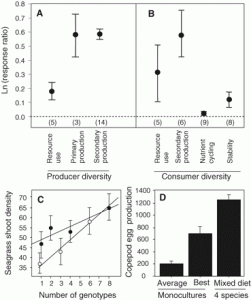Diversity for Sustainability
Throughout my life I’ve always seen a balance with everything. Too much of one thing is not ideal, but not having enough is not ideal either. I was looking for papers to blog about fish sustainability in our oceans, and I found an article that stated right in the abstract that there are two sides to the issue. One side sees universal failure in fisheries management and wants to use protected marine sanctuaries as the ultimate tool to try to rebuild the state of the marine ecosystems around world. This has been done in various locations around the united states with many positive results.
On the other side of the issue are people who are working in fish industries who realize that there have been numerous failures in the management of ocean fishing. But there have also been success stories, and instead of simply making sanctuaries, “This group argues that we need to apply the lessons from the successful fisheries to stop the decline and rebuild those fisheries threatened by excess fishing.â€
Worm et al. stated that if fish stocks keep declining in the same rate as they are now that the world fish stocks will collapse by 2048. With collapsed stocks, diversity of an ecosystem shatters. Worm et al. proposed that the health of a habitat is directly reliant on the diversity that it holds. They set up 32 controlled experiments as well as 12 estuarine experiments to examine the effects of variation of marine diversity of fauna and flora, resource use, and nutrient cycling. They found that increased diversity enhanced all ecosystem processes.
He found that the more diversity an environment contained, the more capable it was to withstand stress; a factor quite important in these environmentally stressful times.
A proposed explanation was given to explain the advanced recovery at high diverstiy: fishers can switch more readily among target species, and therefore providing overfished species a chance to recover. By restoring biodiversity in the marine habitats through sustainable fisheries, pollution control, and the creation of marine reserves (as stated above), we can reliably invest in what our oceans provide us.
Annoyingly so, I love seafood. When you become a marine biology major, you realize how far we are away from having sustainable fisheries, and it can be quite disgruntling to discover that what you love to eat is not a sustainable food source. But now I carry a seafood watch card in my purse that was released through the Monterey Bay Aquarium.
Here at the Friday Harbor Labs we’ve had some fish for dinner here and there. Most of the selection is Tilapia, and most tilapia comes from fish farms, which is debatably sustainable. Yesterday I was surprised that King Salmon was put on the menu as our main entrée here at the labs. King salmon, also known as Chinook salmon, is considered to be a threatened species in the Puget Sound area. I thought that it was so ironic that a marine science laboratory would have that particular fish on the menu here. Although it’s endangered and threatened in many areas along the Pacific Coast, there are some sustainable practices of Chinook in certain areas, such as wild caught Alaskan salmon. Chinook salmon also happens to be the orca’s favorite type of salmon to eat.
This being said, it is vital for our endangered southern resident killer whales that we do the above suggestions: create marine sanctuaries and create regulations of fishing to maintain diversity and the ecosystem’s ability to handle stress from a rapidly altering environment. There has always been a sense of “freedom of the sea†and the idea of regulations on fish stocks is relatively new. But due to our intense fishing practices, regulations must be installed if we or other creatures depending on fish such as killer whales want to able to fish in the future, especially for the threatened King salmon.
Read More



 Twitter
Twitter LinkedIn
LinkedIn Facebook
Facebook